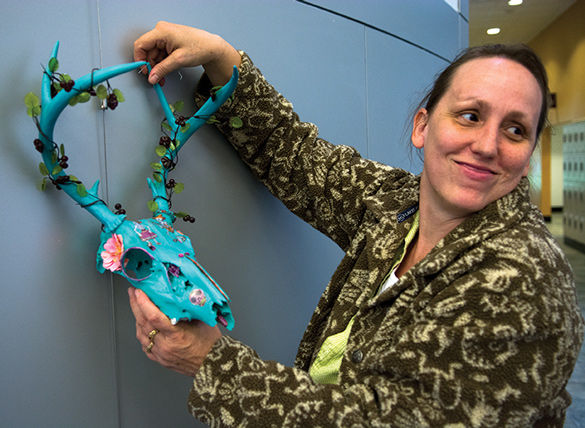Respecting and celebrating the dead

September 16, 2014
Dia de los Muertos, or “Day of the Dead,” is a Mexican holiday on Nov. 2 celebrated around the world. The holiday honors the death of ancestors through food, art, and other traditions.
The Day of the Dead art exhibit in the first floor rotunda of Morris Library began on Monday and runs through Nov. 15, highlighting the holiday through pieces from local artists.
The idea for the exhibit came from librarian Beth Martell and Ruth Hoak, a first grade teacher at Century Elementary School in Ullin, as a way to understand the Mexican holiday and the migration of the Monarch butterfly during corn harvest season.
Advertisement
The exhibit includes art from 30 artists as well as work from Hoak’s class. The art emphasizes milkweed, an important food for the species.
Some of the artists involved are A.K. Thompson, Anne Silver, Cade Bursell, Cathy Daesch, David Bond and many others.
The world’s ecosystem can be monitored by observing changes in the species of butterfly, Martel said.
“Monarch butterflies migrate each year between North America and their winter sanctuary in south central Mexico,” she said. “Last year, fewer Monarchs returned than ever before.”
The monarch is an example of a thinning species caused by external forces within the environment, which are out of their control, Martel said.
“A loss of habitat, climate change and indiscriminate use of pesticides accelerate ecosystem corruption,” she said. “The monarch suffers.”
The art ranges from paintings to actual models, to written poetry.
Advertisement*
On Nov. 2 a reception will take place in the rotunda from 2 to 5 p.m. and will include a live jazz performance from Ray Barone on piano and Robert Franca playing bass.
The reception will also include a lecture from anthropology professor Robert Barrios.
“[Barrios] has a talent for bringing problems that are vast in scope into focus,” Martell said.
Barrios works in disaster reconstruction and studies how communities recover in the aftermath.
Barrios said one of his fellow anthropologists invited him to her house in Cahuacan, Mexico where she practices the Day of the Dead.
“In Mexico today, it is both a recognition of death as a part of life, and a way of remembering those memories of our families and our kin groups who are gone,” he said.
The Day of the Dead is also linked to the agricultural systems in Mexico.
“It is practice at the time that corn fields and different agricultural fields of subsistence farmers are coming to the end of that productive cycle. It is a way of putting the Earth to sleep,” he said.
Asunción Avendaño Garcia, a graduate student in the department of geography at the National Autonomous University of Mexico, will join Barrios’ discussion about the exhibit and complex political, social and environmental issues surrounding traumatic events around the world.
“Beth’s exhibit combines ideas about these intimate relationships between humanity and our environment,” he said. “That our environment doesn’t determine who we are as people, but our environment does play a role in how we become the kind of people we are.”
For more information on the exhibit, contact Martell at [email protected] or 618-453-4097.
Advertisement







